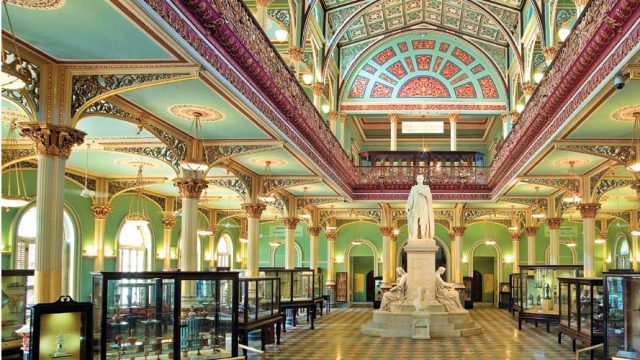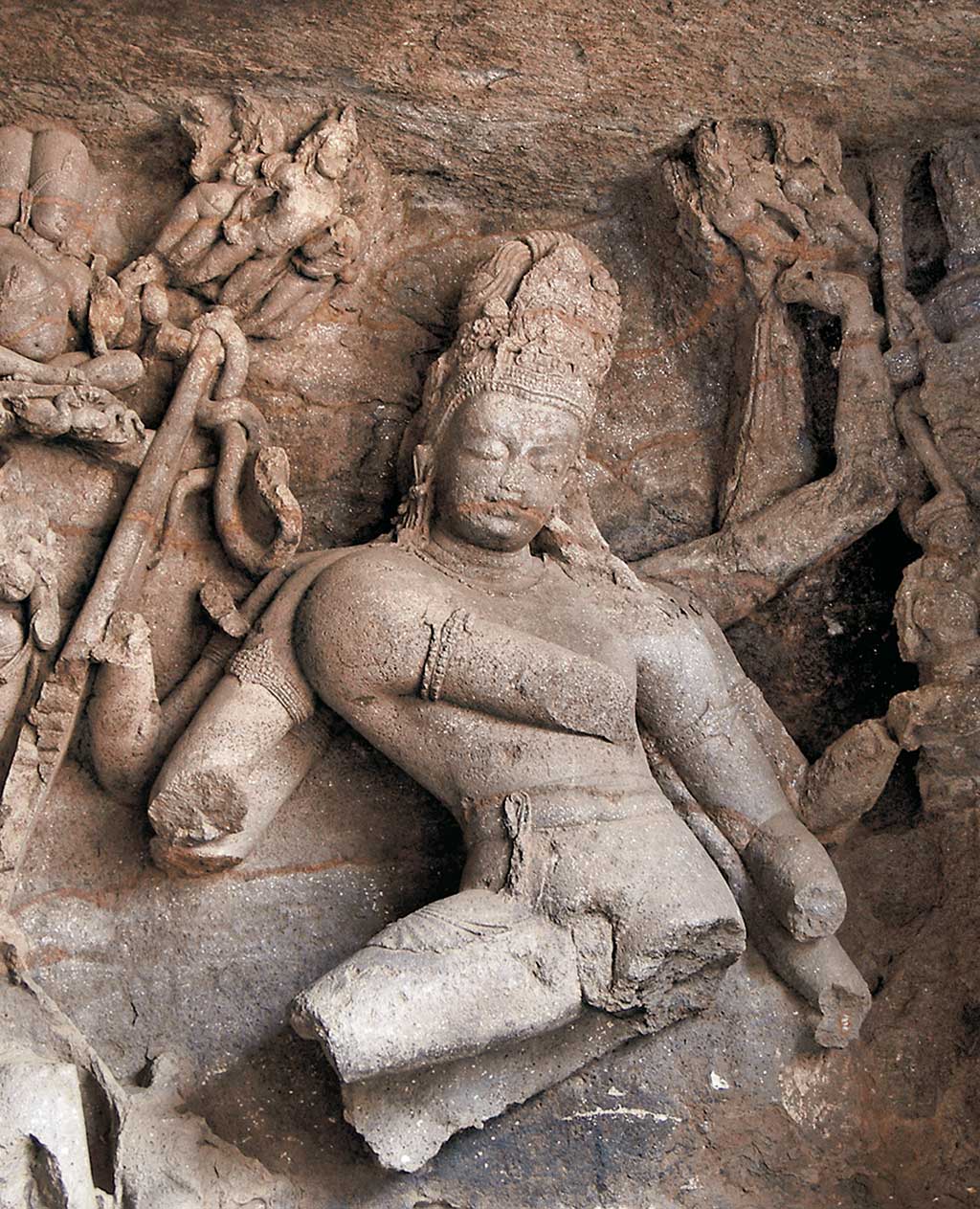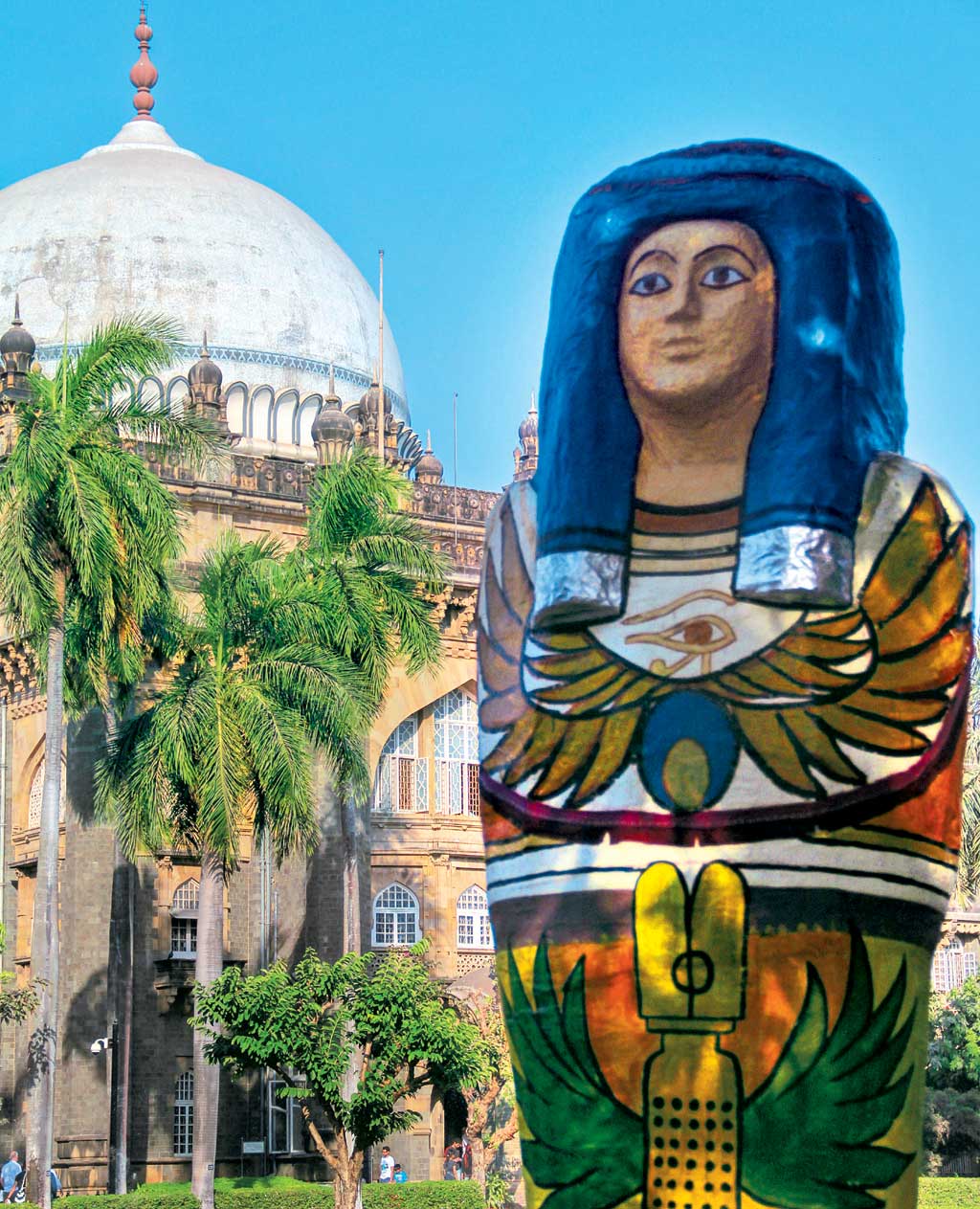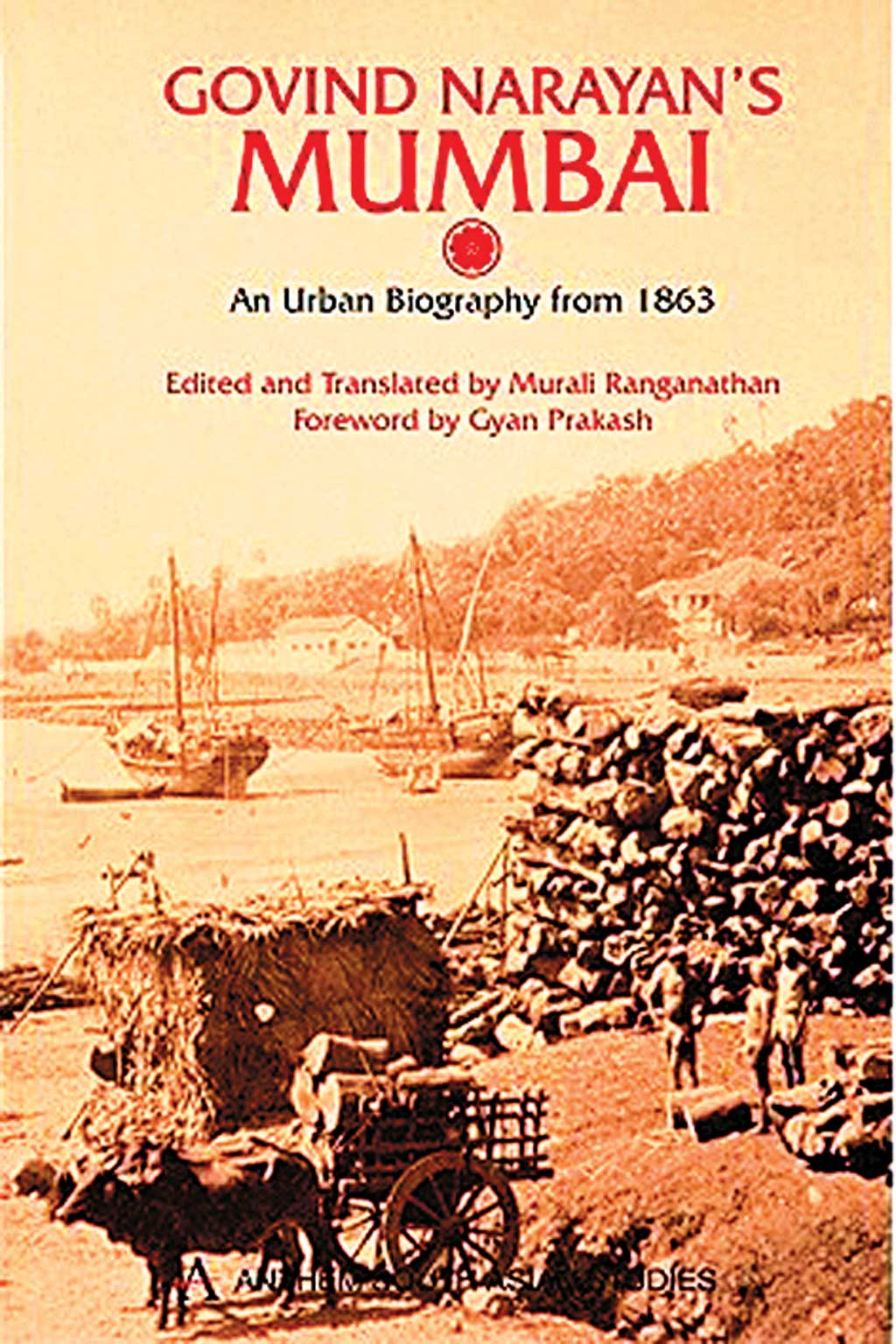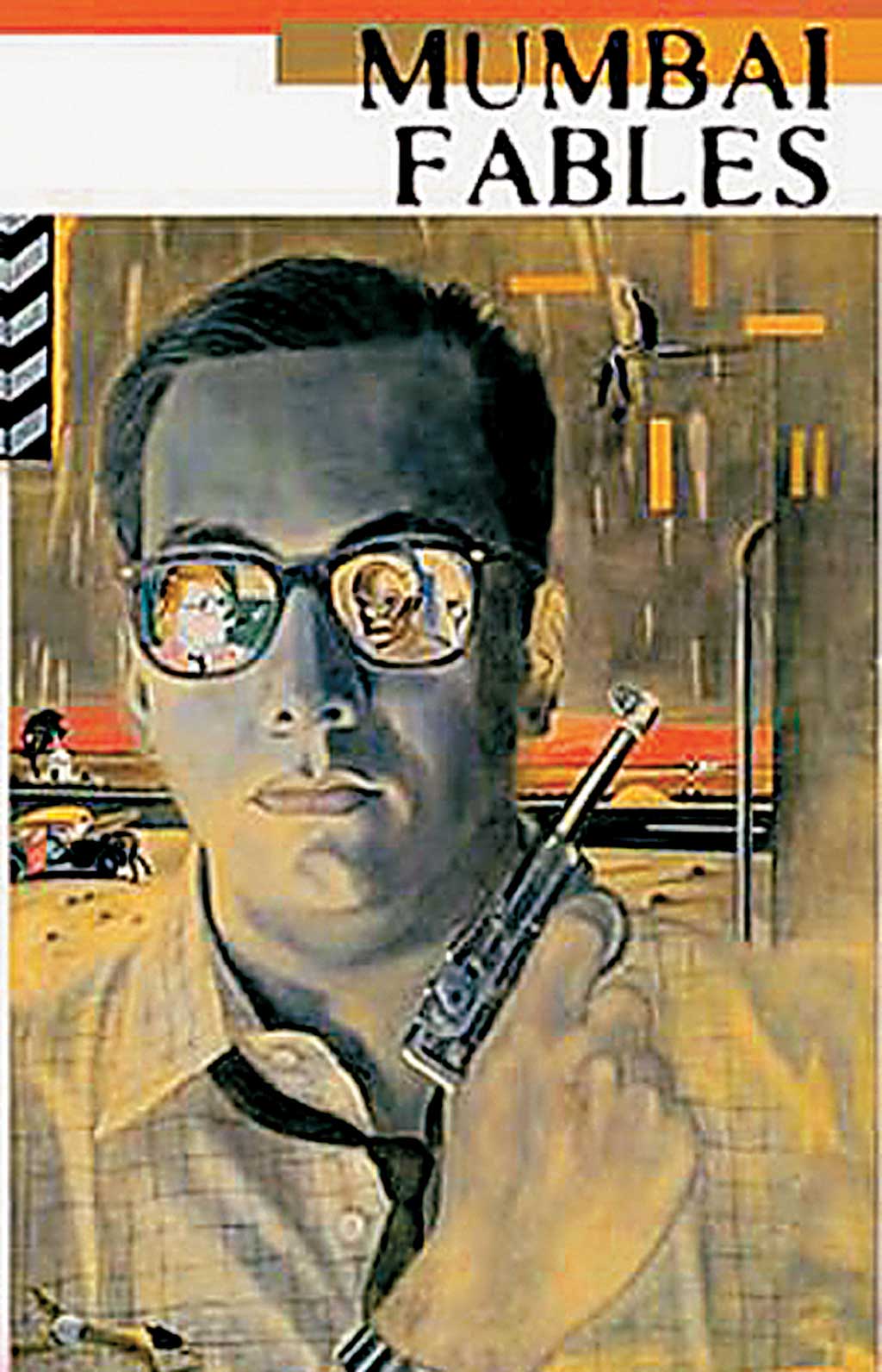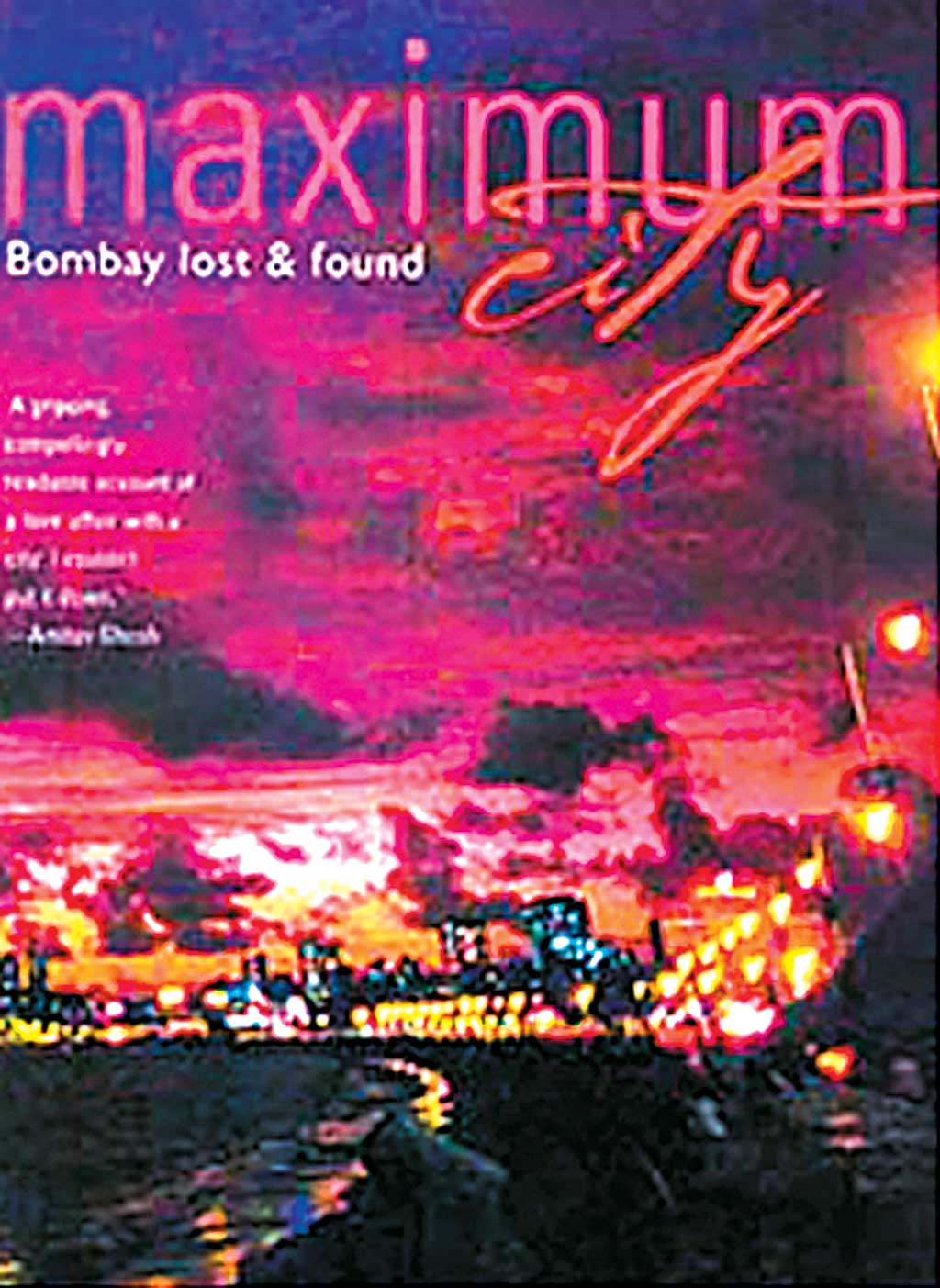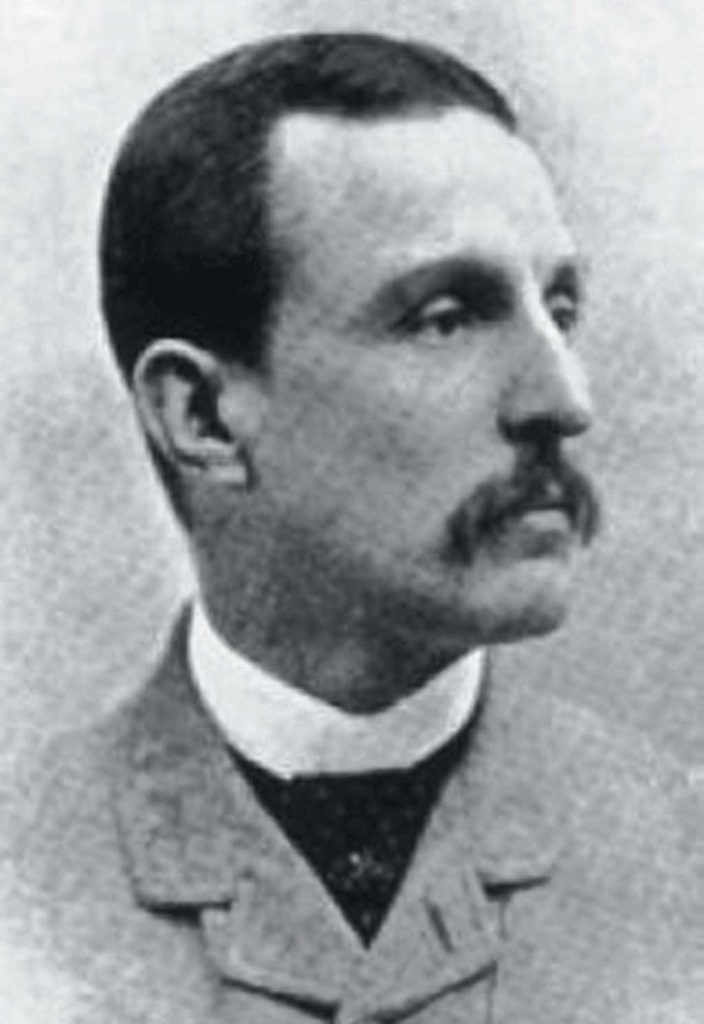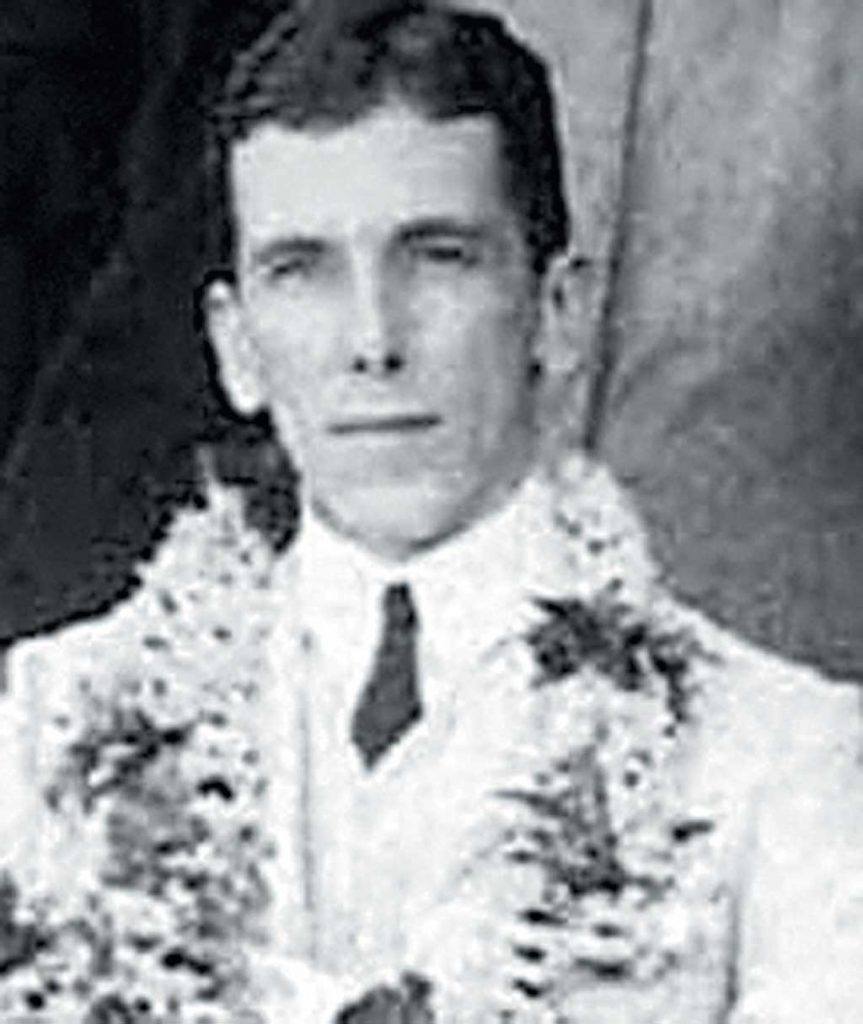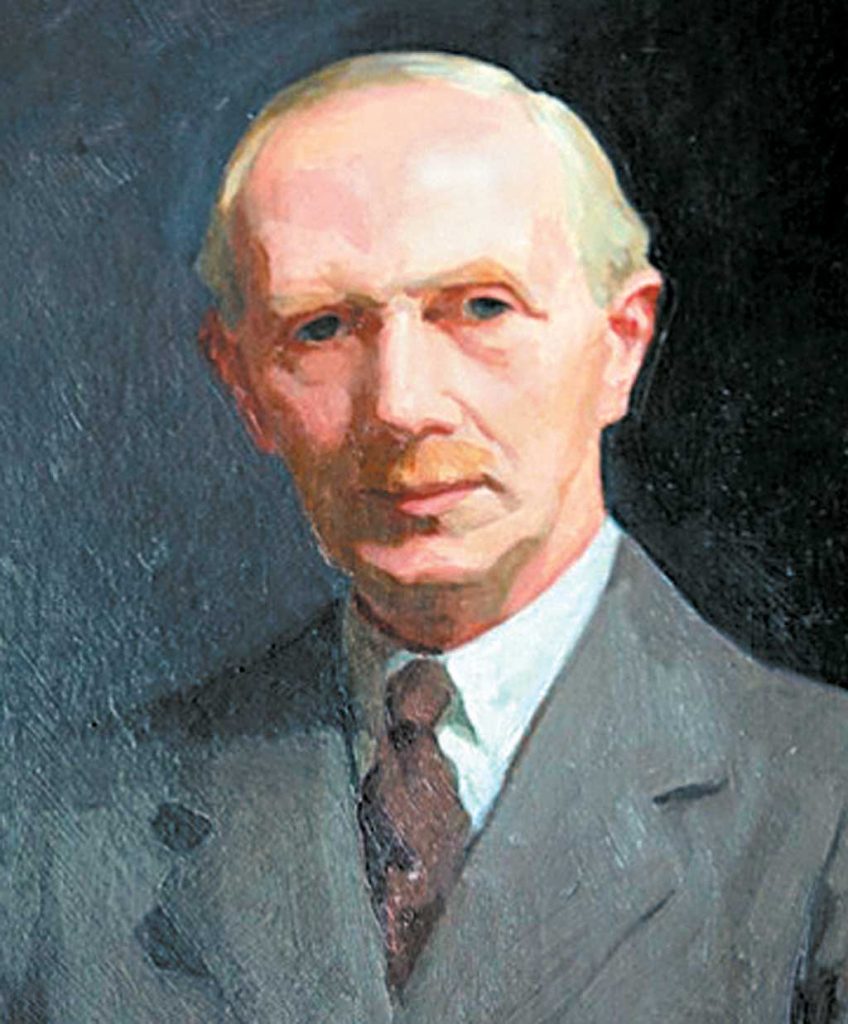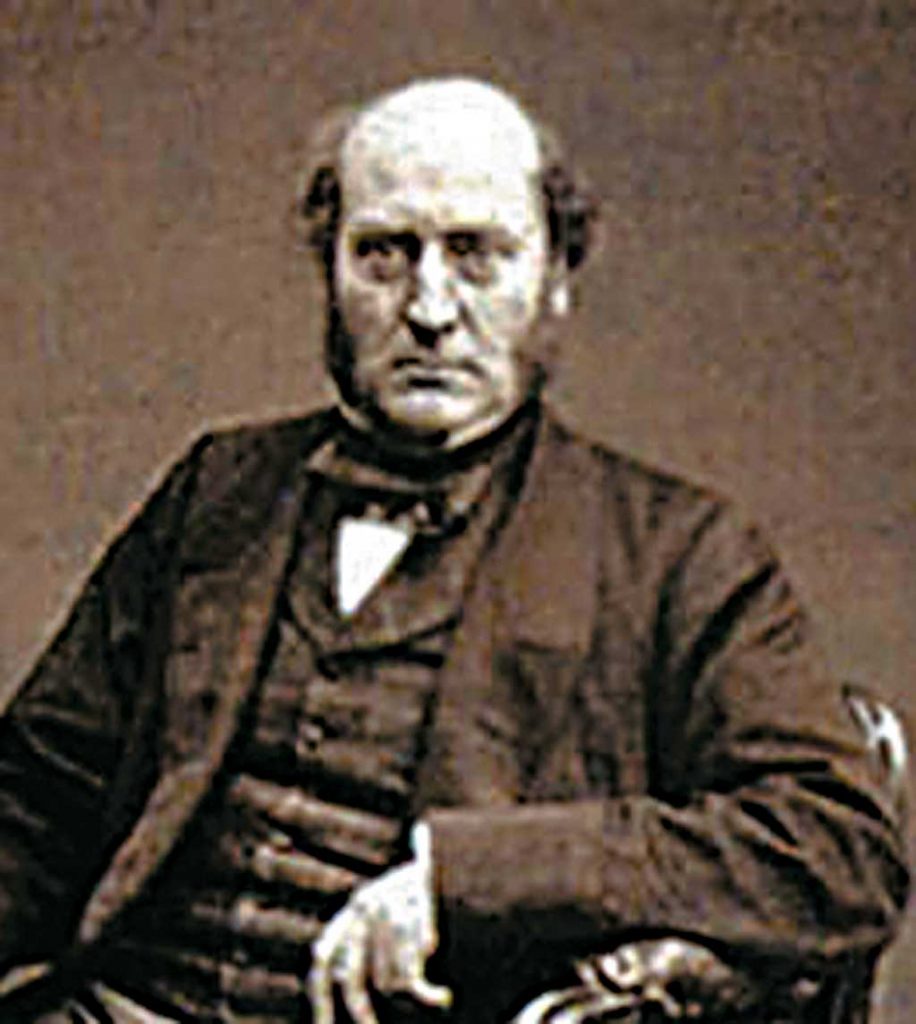Mumbai is, arguably, the most cosmopolitan Indian city, comprised of migrants from all corners of the country and, indeed, the world, who have contributed to its history and bestowed on it a composite culture that has no parallel in India. It has the distinction of being the world’s ninth-most crowded city. Originally this was not even one landmass, but a group of seven disjointed islands inhabited by Koli fishermen and before them, Buddhist monks, who lived in the numerous small hills surrounding the city during Magadhan rule in the 3rd century BCE. Subsequently, Hindu rulers belonging variously to the Rashtrakuta, Silahara and Chalukya dynasties took control of the islands and ruled over them from the 9th to the 14th centuries, after which they had to capitulate the region to the Muslim Sultanate of Gujarat. When the Portuguese acquired the islands from the Sultan of Gujarat in 1534, they named them Bom Bahiya, or the ‘good bay’.

The islands came under the control of the British Crown in 1661 when they were gifted to England as part of a marriage treaty between King Charles II of England and Princess Catherine of Braganza, sister of the Portuguese regent. In 1668, the islands were leased by the Crown to the British East India Company to develop its resources as a natural trading port in the Arabian Sea, and it was this fortuitous event that led to the phenomenal change in the fortunes of this city. Land reclamation projects that began in the early 1700s lasted for over two and a half centuries with the sole purpose of consolidating the island cluster into one giant promontory. The resulting Island City became the seat of governance of the Bombay Presidency of the East India Company and a forerunner in India’s social, economic and industrial growth. The vast commercial opportunities lured merchant Gujaratis, Parsis, Sephardic Jews and many other communities to the port, who contributed to the city’s multicultural identity. Today, as the capital of the Indian state of Maharashtra, the megapolis is the country’s undisputed commercial epicentre.

For a first-time visitor, the sheer size of Mumbai can be intimidating. However, since so many universes coexist in every suburb of the city, it is always possible to find your own niche here. With its Colonial and Art Deco skyscrapers, chock-a-bloc traffic and frenetic pace of life, Mumbai is a unique city, and sifting through its layers of history and rediscovering imprints that each successive generation left behind is an experience like no other.
The vast urban sprawl of Mumbai spans an area of over 600 sq km – a narrow promontory that ultimately juts into the Arabian Sea. The historic Fort in South Mumbai is the proverbial heart of the city, with the best choice of high-end hotels, great restaurants and cultural landmarks. Marine Drive, or Netaji Subhash Chandra Road, curves along a sea facing promenade and connects the suburbs to the city’s main commercial and administrative areas. Most of the city’s posh residential areas lie along the western coastline, just north of Marine Drive. A 10–15 minute drive eastwards from the esplanade leads to Kala Ghoda, Mumbai’s de facto cultural district. Some of the city’s most important museums, libraries, and art institutions are located here, along with famous restaurants and book and music stores.
The suburban areas, such as Andheri, Juhu and Malad stretch further northwards. Three suburban railway lines – Western, Central and Harbour – connect the various parts of the city to each other. Taxis and buses are convenient ways to get around within the city. In the suburbs, auto-rickshaws operate by metre.
Things to See & Do
Any amount of time spent in the ‘maximum city’ is not enough to explore its rich history and beautiful alleys. However, there are certain experiences one should not miss on a trip to Mumbai.
Gateway of India
Undoubtedly Mumbai’s most famous monument, the Gateway of India was commissioned, in theory, to commemorate the visit of King George V and his consort Queen Mary to India in 1911. However, when the royal couple reached the shores of Bombay, they were greeted by a mock structure made of cardboard. The actual building was only completed in 1924, 12 years after the royal visit. After its completion, the iconic structure became the first sight to welcome travellers who arrived in India by ocean liner.
The then governor of Bombay Sir George Sydenham Clarke laid the foundation stone of the monument on 31 March, 1911. However, construction only began in 1915, after Scottish architect George Wittet’s design of the monument was sanctioned in March 1913. Wittet combined elements of the iconic Roman triumphal arch and traditional Gujarati architecture of the 16th century to create the look of the structure. Yellow basalt and reinforced concrete was used for construction. While the stone was sourced locally, the perforated screens in the base of the monument were brought from Gwalior. The foundations were completed in 1920, and construction was finished in 1924. The gateway was opened for the public on 4 December 1924, by the then Viceroy of India, the Earl of Reading.
The Gateway, the city’s most popular communal space, teems with people no matter what time of the day it is. However, it looks absolutely magnificent at night – illuminated and framed against the backdrop of the vast Arabian Sea. Ferries moored at the barge offer regular trips to the island of Elephanta.
Elephanta Caves
The ferry from the Gateway to Elephanta Island transports you, in less than 75 minutes, back to the early centuries of the last millennium. The cave temples here, dating from the 6th century AD, are dedicated to Lord Shiva and are great specimens of Indian sculptural art. Believed to have been carved during a period of Brahmanical revival after the decline of Buddhism in this part of the country, the cave temples are a UNESCO World Heritage Site.
From the pier, a short walk leads visitors to a steep flight of 125 steps that in turn lead to the temples’ entrance – a huge pavilion supported by two dozen pillars. In a deep recess in the rear wall is carved the massive triple-headed Shiva statue, known as the Maheshamurti. The three faces represent the three facets of Lord Shiva as the Creator, the Preserver and the Destroyer. There are other representations of Shiva as well: dancing as the Nataraja; slaying demons; playing chausar (game of dice) with Parvati and as the Ardhanarisvara.
Visit the ASI Museum as well, where the history of Elephanta’s cave temples is presented in an easily understandable format.
Entry ₹ 10 Ferry ₹ 120–150 Timings 9.00am–2.00pm Closed Monday
Prince of Wales Museum
Now known as the Chhatrapati Shivaji Maharaj Vastu Sangrahalaya, this museum is a protected heritage structure. The sheer range of the collection is enough to satisfy even the most discerning connoisseur of art. The museum boasts collections of Indian Miniature Paintings, Far Eastern Art, artefacts from the Indus Valley Civilization, arms and armour, coins as well as relics from the Maurya and the Gupta periods.
- A sculpture at the Elephanta Caves
- Prince of Wales Museum
On a visit to India in 1905, the Prince of Wales (future King George V) laid the foundation stone of the museum on a three-acre semi-circular plot of land, known as the Crescent Site. George Wittet, the then consulting architect to the Government of Bombay, was commissioned to design the structure in 1909. He introduced the Indo-Saracenic style of architecture in the numerous buildings he designed and in doing so changed the visual template of the city. The museum’s base is a three-storied rectangular structure, topped by a dome, and it is set in the centre of a hemispherical garden. The dome, in fact, is said to be inspired by Bijapur’s Gol Gumbaz. Locally sourced basalt and kurla stone were used in the construction of the handsome building.
There are approximately 60,000 artefacts housed in this vast museum divided into three broad categories, Art, Archaeology and Natural History. From the main central hall, a staircase leads to the upper storeys, with galleries branching out on either side. The ground floor has sculpture, the Pre-and- Proto History Gallery and the Natural History section. On the first floor are the Miniature Paintings, Nepalese and Tibetan galleries and decorative arts. The third floor houses European Paintings and arms and armour. The Archaeology collection of the museum boasts Indus Valley artefacts that date back to 3,000 BCE as well as sculptures and figurines from the Maurya-Gupta period (320 BCE–800 CE). All main schools of Indian painting find representation in the miniature painting collection, be it Mughal, Deccani or Rajasthani. In fact, palm leaf manuscripts dating back to the 11th–12th centuries are also displayed. The European Painting galleries showcase some classic landscape paintings by John Constable, an English Romantic painter.
The Natural History section has dioramas and habitat group cases that illustrate the diverse Indian wildlife.
Entry Indian Adult ₹ 70, child ₹ 20; Foreigners ₹ 300 Timings 10.00am– 6.00pm Photography Cellphone camera ₹ 40; Still camera ₹ 200 Closed Public holidays
Bhau Daji Lad Mumbai City Museum
This museum is situated inside a grand Palladian building with high Victorian interiors, which was built in 1858 to showcase industrial arts and life as it was like in 19th century Bombay. The building was opened to the public in May 1872 as the Victoria and Albert Museum. However, lack of regular upkeep resulted in the deterioration of the museum and in February 2003, the Jamnalal Bajaj Foundation along with the Indian National Trust for Art and Cultural Heritage (INTACH) signed an agreement with the Municipal Corporation of Greater Mumbai (MCGM) for its restoration. Today, it contains one of the finest collections related to the city’s origins, history and evolution. The artefacts are kept inside stunning polished wooden cases which are retrofitted with state-of-the-art lighting. The exhibits on the ground floor are objets d’art, ranging from pottery, bronze and metal ware, miniature paintings and ivory sculptures, while on the first floor are dioramas and clay models that trace the history and cultural development of Bombay during the 19th and early 20th centuries.

The most important exhibits are clay model representations of all the communities of erstwhile Bombay. Their attire, occupation, religious beliefs, music, dance and festivals are all documented in painstaking detail. Another section here showcases the urban development of Mumbai from a group of disjointed islands to the sprawling metropolis that it is today through a series of maps, lithographs and photographs.
Entry Indian Adults ₹ 10; Foreigners ₹ 100 Timings 10.00am–6.00pm Closed Wednesday
Jehangir Art Gallery and National Gallery of Modern Art
By far the most famous exhibition space in Mumbai, the Jehangir Art Gallery has four halls that have displayed the works of almost all renowned Indian artists. The museum shop sells reproductions and art print T-shirts, mugs and other collectibles.
Entry Free
Timings 11.00am–7.00pm
The National Gallery of Modern Art was originally Sir Cowasji Jehangir Public Hall and played an important role in Bombay’s public and cultural milieu for several decades. However, the hall, which once hosted rallies by freedom fighters and concerts by Yehudi Menuhin, was eventually overshadowed by newer venues. Renovated and relaunched as the NGMA Mumbai in 1996, it now houses collections from some of India’s best known artists and has, on occasion, exhibited works by legendary artists such as Picasso.
Entry Indian Adults ₹ 20; Foreigners ₹ 500; Children upto standard XII free on presentation of identification Timings 11.00am–6.00pm Closed Monday and national holidays
Mahalaxmi Temple
This temple looks upon the tomb of Peer Haji Ali. The temple was built by contractor Ramji Shivji, who was working on the Hornby Vellard Reclamation Project linking Bombay and the Worli islands. But the embankment kept crumbling into the sea repeatedly, derailing the project. It is said that the devi appeared to Ramji Shivji in a dream and told him to retrieve an idol of hers from the Worli creek. The idol was duly recovered and installed in the temple and the project was completed without any further hindrances.
Mahalaxmi, Mahasaraswathi and Mahakali preside in the temple. The approach to the ornate gateway is along a narrow pathway dotted with smaller shrines to various gods. Great crowds visit the temple during the festival of Navaratri.
Shree Siddhivinayak Temple

This revered shrine dedicated to the elephant god was constructed in 1801 by contractor Laxman Vithu Patil with the financial support and instructions of Late Mrs. Deubai Patil, a rich, childless woman belonging to the Agri Samaj. She had the temple constructed so that other childless women could pray to the Ganapati and have him grant them the boon of offspring.
The sanctum sanctorum is located in the middle of a small mandapam, and has doors on three sides for the entry and exit of devotees. The roof of the sanctum is plated with gold. The deity is depicted with four arms, bearing a lotus, an axe, modaks and a garland of beads respectively. The idol is built of black stone, has a third eye in the middle of the forehead and has a serpent around its shoulders.
Haji Ali
This dargah is amongst Mumbai’s most important places of worship, connected to another – the Mahalaxmi Temple – by a small path that goes into the sea, accessible only at low tide. Built in 1431 or thereabouts, it is the tomb of Haji Ali, a merchant who renounced his wealth before setting off for Haj, the Muslim pilgrimage to Mecca. Legend says he died on the pilgrimage and his casket was found floating near the isles of Mumbai, where the dargah now stands.
Cross the long causeway and enter the marble courtyard. Offer a chadar at the silver-framed tomb, supported by ornate marble pillars on which are engraved the 99 names of Allah. Haji Ali’s picturesque location has a certain romance attached to it; jutting out to sea, its face turned towards Mecca, the mosque is highly revered. Over the years, it has been known to have fulfilled the wishes of the numerous devotees who come here in large numbers.
Haj House
Though not a place of worship, the imposing edifice of Haj House is a useful geographical marker, standing just south of CST at the start of Mohammed Ali Road, Mumbai’s most vibrant Muslim hub. Several verses from the Koran are inscribed on Haj House’s marble jaali façade. Built by the Central Haj Committee after the neighbouring Musafirkhana could no longer cope with the ever growing numbers of pilgrims, Haj House serves as accommodation and central hub for the thousands of would-be Hajis who make their way towards Mecca through Mumbai every year. It is everything from travel agency and foreign exchange dealership to guide and hotel.
Next to Haj House is the colourful Dargah of Pedru Shah Baba, or Syed Abdulla Shah Qadri, a tomb which predates the railway line behind it. Within is buried an Iraqi pir said to have settled in Mumbai at the end of the 18th century, and died in 1903.
St Thomas Cathedral
This Anglican church, which gives Churchgate Station its name, stands opposite Horniman Circle Gardens. Churchgate was the station that terminated outside the Fort gate closest to St Thomas Church, a gate whose location is now occupied by Flora Fountain.
The church took four decades to build, with work starting in 1672 and the main structure completed in 1718, with cow dung floors. In 1816 it was dedicated to St Thomas, and in 1838, the tower and clock were added and it was declared a Cathedral. The chancel was built in 1863. The church became the centre of the British-ruled city of Bombay, and was the point from where distances in the city were measured. The church also serves as a museum of Indo-British history, making it an unmissable monument for seekers of this city’s heritage.
It houses a chalice gifted by Gerald Aungier, the city’s third governor, and memorials honouring Col John Campbell for his successful engagement against Tipu Sultan. Sir Cowasjee Jehangir Ready money dedicated the church’s fountain.
St Thomas still sees an influx of visitors. Crowds of all faiths turn up here at Christmas to see the beautiful displays and decorations.

Mount Mary Church, Bandra
On 8 September, all roads in Mumbai lead to the Basilica of Our Lady of the Mount, simply known as Mount Mary. Established by converted Kolis, made accessible and rebuilt by Parsis, worshipped by all, Our Lady of the Mount is the most miraculous testimony of Mumbai’s secular character.
Legend claims the statue of Our Lady was fished out of the sea by Koli fishermen in 1556, who installed her in a thatched hut chapel in the Portuguese Castella de Aguada Fort at Land’s End, Bandra, and worshipped her as the mother of the seas. In 1640, the Portuguese upgraded the structure to the Nossa Senhora de Monte Church, but it remained relatively obscure, since it was accessible only by a small pathway from Bandra fort. Few ruins of the fort remain today, but the chapel has become greater and grander and towers over all it surveys. When pirates attacked the church in the 1700s, they chopped the right hand of the statue of Mary, mistaking the painted wooden spectre for gold. The arm was restored in 1761, this time, holding baby Jesus.
A famous story of the church’s eminence is as such. After the demise of his infant daughters, famous Parsi philanthropist Sir Jamsetjee Jeejeebhoy and his wife vowed at the church, in 1833, that if a daughter of theirs lived beyond seven years, he’d build a causeway at Mahim.
In 1834, Pirojbai was born. When she lived beyond the desired age, her father kept his word. And thus came into being the Mount Mary Steps going up the eastern side of the hill, and Mahim Causeway, both to ease the pilgrim’s passage and built on the condition that pilgrims would be charged no toll. Later, the church was also upgraded by a Parsi, Shapoorjee Chandbhoy, and conse crated on 11 May, 1902. The present crown that lies on Mother Mary’s head was personally sent by Pope Paul VI from the Vatican in 1970.
Marine Drive

Stretching from Nariman Point to Malabar Hill in the north, Marine Drive (Netaji Subhash Chandra Road) is Mumbai’s iconic thoroughfare. This 4.3 km long boulevard runs parallel to a wide sea facing avenue, and is the link between Mumbai’s suburbs and prime commercial areas. At night, when the street lights illuminate the entire semi-circular stretch, it resembles a glittering string of pearls and thus is aptly called the “Queen’s Necklace”. Most of the buildings lining the drive flaunt an Art Deco flavour, which became very popular in Bombay in the 1930s and 40s. The avenue by the sea is a favourite haunt of Mumbai citizens, who flock here for their morning and evening walks, or just come here with their families to sit on the parapets and enjoy a spectacular view of the sea.
Sanjay Gandhi National Park
Nature enthusiasts must not miss a trip to the Sanjay Gandhi National Park (SGNP), squeezed between Mumbai and Thane, the only national park in the world that falls within the municipal limits of a metropolis. At Borivali, a sudden turn off the Western Express Highway takes you from the endless stream of trucks, noise, pollution and people, bang into the middle of wilderness. Don’t let the unimpressive main gate fool you. Almost as soon as you’ve bought your ticket and begun the journey, you notice a perceivable drop in temperature, lose the connectivity on your cellphone and grudgingly admit that this, indeed, is the wild.
There are an estimated 40 leopards in SGNP (often sighted by day) and neighbouring Tungareshwar Sanctuary. Sadly, the leopard-human conflict in SGNP has escalated in recent years. But this hasn’t deterred locals from coming here for their morning walk, yoga or spiritual sustenance. The park receives an estimated 8,000–10,000 visitors every day. This number increases to one lakh during Shivratri, when devotees throng the Mahadeo Temple near the Kanheri Caves.
The park is spread over 103 sq km and more butterfly and bird species are seen here than in all of the UK. You can see some of the former at the Nature Interpretation Centre’s Butterfly Garden, a 5-minute walk from the main entrance. The centre organises programs for visitors all year. See rare lilies and insects in the monsoon, reptiles in August and September, butter flies and birds (both migratory and local) from winter to summer. The centre also organises half-day nature trails. It is vital that visitors book these trips a few weeks in advance since special permissions need to be obtained to wander beyond the 5 sq km area that the public can access up to 7.00 in the evening.

There are two lakes here – Vihar and Tulsi – that are water reservoirs for Mumbai. The park’s core area forms the catchment area of the lakes and is off-limits for visitors. The Bombay Natural History Society (bnhs.org) centre and museum, ahead of the NIC, organises day tours through these forested areas, which are particularly beautiful in the monsoons. They’ll take you to Tungareshwar Wildlife Sanctuary, to Salim Ali Point, and along the Shilonda Trail among other nature and bird-watching trails. Beyond the NIC and BNHS is the SGNP Office. Ride the Van Rani, or toy train complete with miniature railway station across the 2.5 km track to the Mahatma Gandhi Memorial on the 620 ft Pavilion Hill.
The Gandhi memorial itself offers views of the park at one side and the sprawl of Borivali on the other. The Kanheri Cave Complex in the middle of the park lies along an extremely picturesque but very isolated route through the forest.
It is not safe to take this path unless you are in a large group. Incidents of theft and mugging have been reported from time to time. It’s not advisable to visit alone, or even in pairs. Built between the 1st and 9th centuries AD, the Kanheri Leni is a cluster of 109 cells, a prayer hall, a stupa, water cisterns, and resident halls within which are carved ornate statues of Buddha and the Bodhisattvas. Take a moment to survey the park from a slight elevation from the Buddhist monastic caves.
The verdant expanse before you, the ancient volcanic rock of the caves behind you and the forest air filled with birdsong makes even a lingering memory of the city disappear.
SHOPPING
Mumbai offers some of the best shopping in India. From fish to fashion, bread to books, attar to auto parts, murabbas to matkas, everything can be found within the precincts of its bazaars.
Cuffe Prade, Colaba
On the opposite side of Colaba from Sassoon Dock is the Cuffe Parade stretch. Near the Taj President Hotel is Maker Arcade, among the first shopping centres in Mumbai, which continues to offer a wide range of cosmetics, confectionary, designer clothes and shops selling knickknacks. The World Trade Centre just a little ahead houses several state emporia that display the range of handcrafted fabrics, carpets, brassware, papier-mâché trays and bowls. WTC also hosts exhibitions all year round, including Comic Con, Gift Expo, travel and festival exhibitions, especially during Diwali.
Colaba Causeway, Colaba

Heading north from Sassoon Dock, Colaba’s famous tourist shopping avenue, Colaba Causeway, opens up before you. The major shopping stretch lies between Apollo Bunder and Regal Cinema, with many boutiques on the lanes leading off the causeway. Home to everything from top fashion labels to cheap junk jewellery, Colaba Causeway is a great place to strike bargains, window shop, or just take in the heritage sites around one of Mumbai’s defining streets.
Lower Parel
The Lower Parel Strip starting from Raghuvanshi Mills to Kamla Mills is simply the hippest place in Central Mumbai to shop, eat, watch a movie or just hang out. This stretch is known for both apparel shopping and home decor. The High Street Phoenix- Palladium Complex with entertainment from bowling to gaming, a massive Hamley’s store, an eight-screen multiplex and an excellent clutch of restaurants, has become the place where Mumbaikers go to hang out. Some of the apparel stores here include Marks & Spencer, Provogue, Wrangler, Levi’s, FCUK, Black Soul, Ed Hardy, Zara, Emporio Armani and DKNY.
Where to Stay
The Taj Mahal Palace and Towers (Tel: 02266653366; Tariff: ₹ 30,000– 8,00,000), has been offering the best views of the sea and the Gateway for over a century, and some of Mumbai’s most famous restaurants. The Oberoi (Tel: 66325757; Tariff: ₹ 25,000– 7,50,000) at Nariman Point, is another excellent option for lovely sea views. Ditto The Intercontinental Marine Drive (Tel: 39879999; Tariff: ₹ 19,500– 97,500). A cheaper South Mumbai sea-view option is Marine Plaza (Tel: 22851212; Tariff: ₹ 7,500–18,000) at Marine Drive. Taj Land’s End (Tel: 66681234; Tariff: ₹ 26,500–3,00,000), in Bandstand, is a posh address in Bandra. Plenty of luxury hotels for Juhu, especially in the area next to the beach, including Ramada Hotel Palm Grove (Tel: 67371600; Tariff: ₹ 17,000–25,000) and the JW Marriott (Tel: 66933000; Tariff: ₹ 15,000– 75,000), Sun-N-Sand (Tel: 26201811; Tariff: ₹ 9,000–45,000), is an old favourite to enjoy some good times by the beach.
For affordable stays in ideal locations, consider the well-maintained YWCA International Guesthouse (Tel: 22025053/ 9161/ 0598; Tariff: ₹ 3,672–7,252) at Fort; Grand Hotel (Tel: 6658050006; Tariff: ₹ 5,800–7,000) at Ballard Estate; Bentley’s Hotel (Tel: 22841474/ 733, 22882890, 22823245; Tariff: ₹ 3,295) in Colaba; Hotel Outram (Tel: 22094937, 22004322; Tariff: ₹ 1,100– 3,267), also in Fort area and Marina Guest House (Tel: 66370056; Tariff: ₹ 1,686–2,486) at Marine Lines. Dadar can be a convenient hub. Try Hotel Parkway (Tel: 24453362-63; Tariff: ₹ 3,789–4,737) and Midtown Pritam (Tel: 24145555, 4344999; Tariff: ₹ 6,000–12,000).

Where to Eat
Among the local legends, you have the deified vada pav at Vaidya’s, outside Dadar Station, Colaba’s Bade Miyan for nocturnal non-vegetarian rolls, Shiv Sagar at Juhu or the Bollywood-wannabe-favourite Urban Tadka at Andheri West. Unmissable institutions – all on Colaba Causeway – include Café Leopold, overflowing with foreign tourists; Café Mondegar, with Mario Miranda on the walls and a jukebox as famous as the draught beer; and Olympia, an old joint for inexpensive, authentic Chilla Muslim fare.
Apoorva, near Horniman Circle, is great for Mangalorean seafood. For lip-smacking neer dosa and crab, there’s Mahesh Lunch Home, Fort. Trishna Restaurant at Kala Ghoda serves great crab. Swati Snacks in Tardeo is the place for excellent Gujarati fare. Their panki chatni is great, the methi roti with peru shak is outstanding, and their fada ni khichadi is very popular. Britannia, a lovely, old-fashioned Parsi eatery in Ballard Estate, has delicious berry pulao and caramel custard. Jimmy Boy, off Horniman Circle, also serves Parsi cuisine. Paradise at Colaba Causeway serves Parsi, Chinese and Conti-nental cuisine.
Indigo near the Gateway of India and Indigo Deli at Apollo Bunder offer varied Continental choices in lovely surroundings.
Try Theobroma’s bakery products in Colaba Causeway; Moshe’s Café, Kala Ghoda and Ideal Corner, Fort; and drop in at the open-air café at Prithvi Theatre, Juhu for Irish coffee and brownies.
Books on Mumbai
To begin a literary love affair with the city, start at the beginning with the first full account of life in Mumbai, Mumbaiche Varnan, written in 1863 by Govind Narayan in Marathi; it was edited and translated into English by Murali Ranga-nathan and called Govind Narayan’s Mumbai: An Urban Biography from 1863. Gyan Prakash’s Mumbai Fables looks at the history of the city through the eyes of its artists and activists. Rohinton Mistry’s Family Matters and Tales from Firozsha Baag offer glimpses of the Parsi way of life and a peek inside a fictional Mumbai Parsi colony. The late Sharda Dwivedi’s Mumbai: The Cities Within, and Bombay Then and Mumbai Now written by Naresh Fernandes, Jim Masselos and Chirodeep Chaudhuri bring the history of the conjoined isles and the struggles of the modern city alive with a series of beautiful archival and recent photos. Kiran Nagarkar’s Ravan & Eddie brings alive life in Mumbai’s chawls, while M Menon’s One Hundred Years, One Hundred Voices is a carefully documented oral history of life in Girangaon.
- Books on Mumbai
S Hussain Zaidi’s Black Friday traces the investigation of the serial blasts of March 1993, and Dongri to Dubai uncovers the history of the Mumbai mafia. To learn about Mumbai’s labour class, read Kalpana Sharma’s Rediscovering Dharavi: Stories From Asia’s Largest Slum and Katherine Boo’s Behind the Beautiful Forevers, both introductions to extraordinary tales of survival in the legendary slums of an unequal city. More stories of struggle lie within Sonia Faleiro’s Beautiful Thing: Inside the Secret World of Bombay’s Dance Bars. Also unmissable are Murzban Shroff’s Breathless in Bombay, Kaiwan Mehta’s Alice in Bhuleshwar, and Suketu Mehta’s Maximum City: Bombay Lost and Found. For many aspects of the city within one cover, pick up Jerry Pinto and Naresh Fernandes’ anthology Bombay, Meri Jaan: Writings on Mumbai, with stories by Salman Rushdie, Dilip Chitre, Saadat Hasan Manto, VS Naipaul and Busybee, among others.
The Many Architects of Mumbai
In 1911, John Begg set a design trend that was to become very popular in erstwhile Bombay when he built the city’s first Indo-Saracenic structure, the magnificent General Post Office next to the Victoria Terminus. Another building designed by Begg is the Admiralty House on Wodehouse Road, facing Cooperage.
- FW Stevens
- George Wittet
- John Begg
- Sir Gilbert Scott
Carrying forward the Indo-Saracenic theme with gusto, George Wittet designed the Prince of Wales Museum. He also created the more restrained Ballard Estate as a commercial district, the neo-Renaissance Cowasji Jehangir Hall (now the National Gallery for Modern Art) and the Gateway of India.
Possibly the most prolific of the architects of Bombay, Frederick William Stevens designed the Victorian Gothic VT Station (CST; 1888), today a UNESCO World Heritage Site, as well as the Municipal Corporation building across the street. If the Western Railway offices opposite Church gate Station wear their Oriental crowns and Gothic arches with aplomb, we have to thank Stevens’ genius for pulling off the synthesis. Stevens’ first major contribution to Mumbai was the Royal Sailor’s Home (1876), today the Maharashtra State Police Headquarters at Regal Circle.
Sir George Gilbert Scott’s legacy to Mumbai is the very Gothic University complex on the Esplanade. One could spend a week walking in and out of the Rajabhai Tower and the Convocation Hall and keep finding new allusions to literature and folk art in its carvings, stained glass, cornices and cupolas. These are arguably Mumbai’s finest buildings.
Col James Augustus Fuller built the High Court (1871–79) with its central tower crowned by the figures of Justice and Mercy. Major John Hawkins gave shape to the Mint (1824–29) and Thomas Cowper designed the Town Hall (1820– 23), a fine Neo-Classical building.
If colonial architects sketched the spired, domed and gabled South Mumbai skyline, Indian architects stretched it, drawing cityscapes towering over salt pans and marshlands. While the colonial structures came to be associated with their designers, most of the city’s newer buildings are identified with their developers – Lokhandwala, Shapoorji Pallonji, Hiranandani, CIDCO, Lodha and so on.
Hafeez Contractor is an exception to the phenomenon of invisible, anonymous architects in Mumbai today. His more remarkable postmodern buildings include CG House in Worli, IL&FS building in BKC and ITC Grand Central in Parel. Less creditably, Contractor has designed miles of indifferent buildings in Powai.
Town Hall
The Town Hall is one of Mumbai’s oldest surviving colonial buildings. Built in 1833, it houses the Asiatic Society of Mumbai and Central Library. Designed by Colonel Thomas Cowper, it is among India’s finest Neo-Classical buildings. Facing west and fronting Horniman Circle, the 200-ft-long, well-proportioned façade has three columned porticoes. A magnificent flight of 30 steps leads up to the central portico, surmounted by a gigantic triangular pediment supported on eight fluted Doric columns. The front portico leads into the Assembly Hall once used for public gatherings, now a public reading room. The south wing houses the Durbar Hall, a venue for lectures and exhibitions.

The Library in the north wing has retained its old-world interior. The entrance vestibule is adorned with marble statues of the city’s founding fathers. A beautiful curving double staircase with ornate wrought iron railings leads down to the conservation laboratory. The Library has an invaluable collection of over a 1,00,000 books including rare manu scripts in Sanskrit, Prakrit and Persian, old Bombay gazetteers, ancient Buddhist relics, a unique coin collection, excellent maps and much more.
Horniman Circle Gardens
Horniman Circle Gardens were once the location of the old Bombay Green, a vast open space in front of the Town Hall. It was used as a meeting point for cotton traders, and bales of cotton were transported from here to the docks and shipped out.

Following the demolition of British fortifications in the 1860s, urban improvement and planning of new districts became a priority. Among the first projects undertaken was the restructuring of Bombay Green between 1869 and 1872. The area between two landmarks, the Town Hall and St Thomas’ Cathedral, was laid out as a circular public garden with a fountain at the centre. Forming two elegant crescents on either side of this garden came four Neo-Classic buildings designed by James Scott. Completed in 1873, these buildings share identical curving façades with continuous pedestrian arcades and decorative terracotta keystones from England. Representing the city’s first planned business district, it was named Elphinstone Circle. Post-Independence, it was re-christened in honour of Benjamin Guy Horniman, former editor of the Bombay Chronicle and supporter of India’s freedom movement.
Original street furniture still used in the garden include the wrought-iron fencing stands, and the ornamental gates with handsome street lamps. A modern iron sculpture stands in place of the fountain, within the central water feature. Horniman Circle Gardens, maintained by the Tatas, also provides a beautiful setting for open-air performances and cultural events, such as the Kala Ghoda Arts Festival.
Parsi Festivals
Like the Hindu calendar, the Parsi calendar is also divided into six seasons, and months thereof. Athough there are many variations of the original calendar, most Parsis in India follow the Shahenshahi calendar. Khordad Sal, the birth anniversary of the Prophet Zarathustra is celebrated in August– September every year and is also referred to as the real New Year’s Day (Nawroze-i-Khas), the common Parsi New Year being referred to as Nawroze-e-Aam.

It is a day of celebration with rangolis being drawn in front of freshly cleaned homes, and comprises much feasting. Pateti, or New Year’s Eve, also called Jamshedi Nowroze, is celebrated with lunches organised by charitable trusts in areas such as Grant Road and Fort. At Marine Drive, there is a small break in the landing with steps leading into the sea. Parsis come here to pray to the yazata (angel) of the waters on Ave Roz nu Parab, when the day and the month dedicated to the yazata coincide. The heritage Bhika Behram well at Churchgate is also worship ped on such days. Adar Roz nu Parab, which falls around the last week of April, is a day for offering prayers to the sacred fire.
NCPA: Mumbai’s Temple of the Arts
The National Centre for the Performing Arts’ vast open spaces, low buildings and grassy paths come as an uplifting experience after the chaos of southern Mumbai. Part of the thrill is the knowledge that here, in the heart of the business district, amidst some of the world’s most expensive real estate, is a quiet place where poets meet. The massive scale of the NCPA also allows it to patronise creative efforts from all ends of the spectrum. A venue for festivals of dance, drama and music, exhibitions of modern art, sculpture and photography, workshops and seminars, screenings and film festivals, this truly is a breather in the smog.

The largest of the NCPA’s auditoria, the Jamshed Bhabha Theatre, with its over-the- top marble staircases and sculptures, generous foyer spaces, plush carpets, an orchestra pit and superb hi-tech acoustics, is the venue for major international stage productions, operas, ballets and classical music concerts. The Tata Theatre is designed in a fan shape around an almost semi-circular stage to meet the acoustic and visual requirements of music and dance. The Experimental Theatre, with its flexible layout, is the preferred venue for innovative performances, while the small-but- intimate Dance Theatre Godrej is used for dance, music and arts education. The even smaller Little Theatre plays host to recordings, film screenings and workshops, while the Piramal Gallery is perhaps Mumbai’s sole exhibition venue that favours photography over other art forms. But the NCPA offers a lot more to culture lovers. There’s a library, the Audio & Film Archives, a modern recording studio and the Amadeus Restaurant. Western classical connoisseurs can also rejoice as the NCPA is the home of the Symphony Orchestra of India.
With a packed festival and event calendar, from popular Gujarati plays to summer workshops for children and electronic mandolin recitals, there’s something for everyone here at Mumbai’s cultural powerhouse.
TIP The NCPA offers membership plans that afford discounts at several retail and hospitality outlets, along with NCPA benefits such as priority booking, privilege seating and free library access
Fashion Street
Mumbai’s eternally popular address for high fashion on a really low budget, Fashion Street owes its success to the coming together of a few hawkers selling export reject clothes and shoes in the late 1980s, and broke collegians looking for good deals. Today, the hawkers have graduated into makeshift shop owners and the collegians are still coming. The latest trends in jeans, skirts, tops, T-shirts, capris, jackets, shoes – you name it and Fashion Street has it at bargain rates. It is expected that you will start bargaining at half the quoted price. At festive times such as Navratri, you’ll also find ghaghra cholis and other traditional outfits here.
Location On the edge of Cross Maidan along MG Road, opposite Bombay Gymkhana
Fast Facts |
When to go October to March. It’s green and cool in the monsoon (mid-June to August), but heavy showers here could also mean no trains and flooded roads |
Tourist Offices |
MTDC |
Tourist Information Centre |
Tourist Information Centre Location Spread linearly along the Arabian Sea on the west coast of India Distance 545 km S of Gandhinagar; 1,485 km SW of New Delhi Route from Gandhinagar NH8 via Vadodara, Valsad and Vapi Route from New Delhi NH8 via Jaipur, Ajmer, Palanpur, Ahmedabad and Vadodara |
Getting There |
Air Mumbai has an international and a domestic airport, both named after Chhatrapati Shivaji. Flights from across the world land at the international airport (in Sahar, Andheri East) while the domestic airport (in Santacruz East) is connected to all metros and many smaller destinations. Prepaid taxis available at both terminals |
Rail Key stations are CST (formerly VT), Mumbai Central, Lokmanya Tilak Terminus (LTT) at Kurla, Bandra and Dadar. Mumbai is well connected to the rest of the country by its excellent railway network. Western Railway, Central Railway and Konkan Railway are the divisions of the Indian Railways which serve Mumbai |
Road Connected to Jaipur and Delhi by NH8; to Agra by NH3 via Nashik, Indore and Gwalior; NH4 to Pune via Lonavla, and NH9 to Hyderabad |




